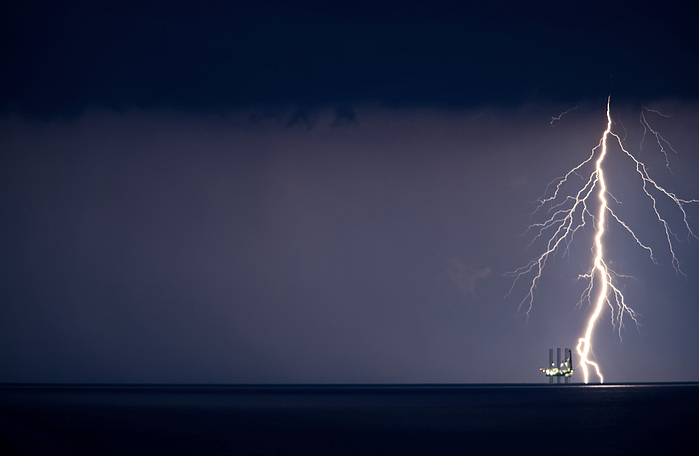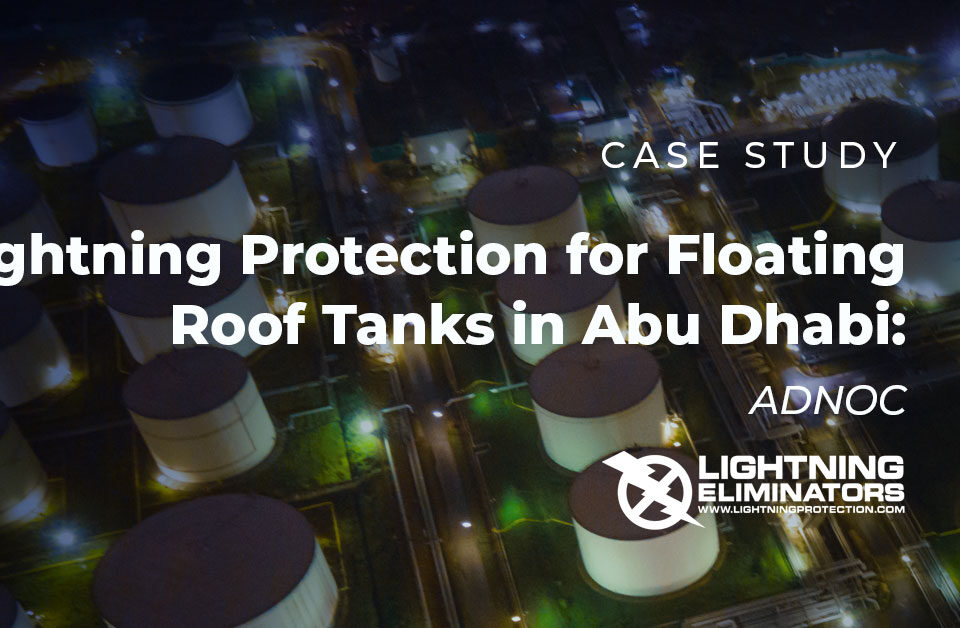- We Prevent Lightning Related Problems.

Spark, Arc and Boom!
July 10, 2014
Lightning Protection: What you should know and don’t!
July 31, 2014Offshore Rigs and Platforms: Not Immune to Lightning’s Wrath!

Lightning Protection Blog
Week 92 | July 24, 2014
I wrote about this in April, however I feel the need to revisit the topic. We have received a number of calls from offshore facilities in recent months, which energized me to create a new solution overview specifically for offshore rigs and platforms and I thought what better place to share it than in the Lightning Protection Blog. Enjoy!
Offshore rigs and platforms are thought of as “grounded” to the ocean. However, the environment, and even the design of the facility itself, may lead to a compromise in bonding with rust and oil deposits that impede the energy’s path to ground. This leaves the advanced electrical and electronic systems and personnel susceptible to severe damage from not only direct strikes but dangerous secondary surge effects of lighting as well.
When it comes to threatening the offshore community, thermodynamic processes typically start near shore and can evolve into open water events. As a result of continuing changes to our climate lightning events are becoming more frequent, severe and stronger. Areas that were not subject to much lightning in the past are experiencing storms and strikes more often which is creating a growing need for protection both onshore and offshore. Rigs and platforms make for an ideal offshore target.
The Goal
- Assess vulnerability to determine proper solutions
- Protect vessels against direct strikes and secondary surges
- Reduce downtime and associated costs
- Extend facility life through preventative measures
- Improve level of safety for the workforce
STEP 1: The Risk and Service Assessment
Not every case is the same, so LEC starts with a *risk assessment to determine the level of vulnerability the rig or platform faces based on IEC and NFPA guidelines and standards. LEC engineers interview key rig/platform technical personnel, review schematics and wiring diagrams for crucial components and inspect in situ grounding practices.
LEC’s site surveys provide sound reasoning for the proposal offered, as each one is tailored to the needs of the rig or platform in question. Some rigs may only need surge protection devices (SPD), which have become critical to protecting power distribution and low voltage instrumentation and control. Other rigs and platforms may need a no-strike system to provide security against lightning strikes on the helipad, drill derrick or jack-up legs.

Helipad Array Solution – PEMEX- Caribbean Ocean
Service Sampling:
- Lightning strike vulnerability and probability
- Consulting in regard to lightning strike vulnerability; primary and/or indirect strike lightning protection.
- Design of lightning protection systems using DAS, SBIs and SPD.
- Primary and/or direct strike lightning protection and surge protection due to the secondary effects of lightning on instrumentation and control circuits – “Meantime – between – failure” solutions provided.
STEP II: The Offshore Solution
Lightning Protection
Dissipation Array®System (DAS®)
The patented Dissipation Array System has over 99% effectiveness and eliminates the threat of lightning-strike formation within a protected area by using charge transfer technology to keep the electrical field below lightning potential. The DAS is a custom-engineered system protecting over 3000 installations worldwide and covered by LEC’s “No-Strike” warranty providing terms and conditions are met. For additional information visit www.lightningprotection.com/das
Spline Ball Ionizer® (SBI®)
The Spline Ball Ionizer is UL listed and used to supplement DAS and/or for structures that require lightweight protection with a low-wind profile. When used as primary protection, the SBI acts as a hybrid ionizer/air terminal, preventing most strikes and collecting any it cannot prevent.

Hemisphere Array – Texaco –Off the Coast of Nigeria
Surge Protection
Lightning and other transients can easily damage or destroy sensitive electronics, causing expensive downtime and repairs. For Rigs and Platforms surge protection devices (SPD) have become critical to protecting power distribution and low voltage instrumentation and control. In some cases, for rigs, this may be the only solution required. However, in most scenarios, it is a combination of SPD’s and DAS working in concert which provides the appropriate and best protection.

One option is Facility Guard (FG-200/FG-400)
Additional options:
Coaxial Line Protector (CLP – 90, 200, 400)
Data Line Protectors (DLP – MHB/LMHB)
SP-DC Surge Protectors (available in multiple operating voltages)
Visit: https://www.lightningprotection.com/surge-protection/ for all surge protection products and information

If you have any lightning stories you would like to share with us, positive or negative and/or if you have any questions or need additional information please feel free to contact me at LightningDiva@lecglobal.com
Be careful out there! Visit www.lightningprotection.com for all your lightning protection needs. Follow us on Twitter, Facebook and LinkedIn for more information and updates as well as some great photos. Thank you for visiting!

